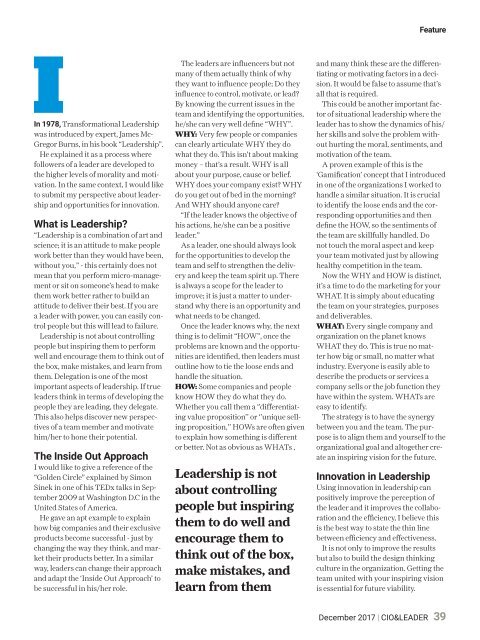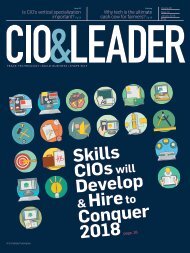C&L_December 2017 (1)
You also want an ePaper? Increase the reach of your titles
YUMPU automatically turns print PDFs into web optimized ePapers that Google loves.
Feature<br />
IIn 1978, Transformational Leadership<br />
was introduced by expert, James Mc-<br />
Gregor Burns, in his book “Leadership”.<br />
He explained it as a process where<br />
followers of a leader are developed to<br />
the higher levels of morality and motivation.<br />
In the same context, I would like<br />
to submit my perspective about leadership<br />
and opportunities for innovation.<br />
What is Leadership?<br />
“Leadership is a combination of art and<br />
science; it is an attitude to make people<br />
work better than they would have been,<br />
without you,” - this certainly does not<br />
mean that you perform micro-management<br />
or sit on someone’s head to make<br />
them work better rather to build an<br />
attitude to deliver their best. If you are<br />
a leader with power, you can easily control<br />
people but this will lead to failure.<br />
Leadership is not about controlling<br />
people but inspiring them to perform<br />
well and encourage them to think out of<br />
the box, make mistakes, and learn from<br />
them. Delegation is one of the most<br />
important aspects of leadership. If true<br />
leaders think in terms of developing the<br />
people they are leading, they delegate.<br />
This also helps discover new perspectives<br />
of a team member and motivate<br />
him/her to hone their potential.<br />
The Inside Out Approach<br />
I would like to give a reference of the<br />
“Golden Circle” explained by Simon<br />
Sinek in one of his TEDx talks in September<br />
2009 at Washington D.C in the<br />
United States of America.<br />
He gave an apt ex<strong>amp</strong>le to explain<br />
how big companies and their exclusive<br />
products become successful - just by<br />
changing the way they think, and market<br />
their products better. In a similar<br />
way, leaders can change their approach<br />
and adapt the ‘Inside Out Approach’ to<br />
be successful in his/her role.<br />
The leaders are influencers but not<br />
many of them actually think of why<br />
they want to influence people; Do they<br />
influence to control, motivate, or lead?<br />
By knowing the current issues in the<br />
team and identifying the opportunities,<br />
he/she can very well define “WHY”.<br />
WHY: Very few people or companies<br />
can clearly articulate WHY they do<br />
what they do. This isn’t about making<br />
money – that’s a result. WHY is all<br />
about your purpose, cause or belief.<br />
WHY does your company exist? WHY<br />
do you get out of bed in the morning?<br />
And WHY should anyone care?<br />
“If the leader knows the objective of<br />
his actions, he/she can be a positive<br />
leader.”<br />
As a leader, one should always look<br />
for the opportunities to develop the<br />
team and self to strengthen the delivery<br />
and keep the team spirit up. There<br />
is always a scope for the leader to<br />
improve; it is just a matter to understand<br />
why there is an opportunity and<br />
what needs to be changed.<br />
Once the leader knows why, the next<br />
thing is to delimit “HOW”, once the<br />
problems are known and the opportunities<br />
are identified, then leaders must<br />
outline how to tie the loose ends and<br />
handle the situation.<br />
HOW: Some companies and people<br />
know HOW they do what they do.<br />
Whether you call them a ‘’differentiating<br />
value proposition’’ or ‘’unique selling<br />
proposition,’’ HOWs are often given<br />
to explain how something is different<br />
or better. Not as obvious as WHATs ,<br />
Leadership is not<br />
about controlling<br />
people but inspiring<br />
them to do well and<br />
encourage them to<br />
think out of the box,<br />
make mistakes, and<br />
learn from them<br />
and many think these are the differentiating<br />
or motivating factors in a decision.<br />
It would be false to assume that’s<br />
all that is required.<br />
This could be another important factor<br />
of situational leadership where the<br />
leader has to show the dynamics of his/<br />
her skills and solve the problem without<br />
hurting the moral, sentiments, and<br />
motivation of the team.<br />
A proven ex<strong>amp</strong>le of this is the<br />
‘Gamification’ concept that I introduced<br />
in one of the organizations I worked to<br />
handle a similar situation. It is crucial<br />
to identify the loose ends and the corresponding<br />
opportunities and then<br />
define the HOW, so the sentiments of<br />
the team are skillfully handled. Do<br />
not touch the moral aspect and keep<br />
your team motivated just by allowing<br />
healthy competition in the team.<br />
Now the WHY and HOW is distinct,<br />
it’s a time to do the marketing for your<br />
WHAT. It is simply about educating<br />
the team on your strategies, purposes<br />
and deliverables.<br />
WHAT: Every single company and<br />
organization on the planet knows<br />
WHAT they do. This is true no matter<br />
how big or small, no matter what<br />
industry. Everyone is easily able to<br />
describe the products or services a<br />
company sells or the job function they<br />
have within the system. WHATs are<br />
easy to identify.<br />
The strategy is to have the synergy<br />
between you and the team. The purpose<br />
is to align them and yourself to the<br />
organizational goal and altogether create<br />
an inspiring vision for the future.<br />
Innovation in Leadership<br />
Using innovation in leadership can<br />
positively improve the perception of<br />
the leader and it improves the collaboration<br />
and the efficiency, I believe this<br />
is the best way to state the thin line<br />
between efficiency and effectiveness.<br />
It is not only to improve the results<br />
but also to build the design thinking<br />
culture in the organization. Getting the<br />
team united with your inspiring vision<br />
is essential for future viability.<br />
<strong>December</strong> <strong>2017</strong> | CIO&LEADER<br />
39














